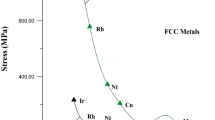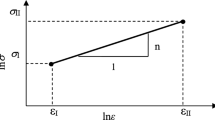We propose a method for the evaluation of the theoretical strength of metal under the conditions of tension and shear. The first of these strengths is determined by comparing the strain energy at the time of fracture with the energy losses required for evaporation. The second strength (obtained on the basis of the data of observations of Luders lines with the help of an electron microscope; × 5000) is found by comparing the strain energy with the energy spent for melting of the metal. The proposed computational formulas do not require additional assumptions about the ultimate strains. We computed the theoretical strength for aluminum, iron, copper, nickel, lead, and zinc. We also experimentally determined the actual strength of 65G steel and its ultimate strain, which coincides with the theoretical value.


Similar content being viewed by others
References
T. Yokobori, Scientific Foundations of Strength and Fracture of Materials [Russian translation], Naukova Dumka, Kiev (1978).
V. V. Bozhydarnyk and H. T. Sulym, Elements of the Theory of Plasticity and Strength [in Ukrainian], Vol. 1, Svit, Lviv (1999).
J. Pokluda, “Theoretical strength of solids: recent results and applications,” Fiz.-Khim. Mekh. Mater., 47, No. 5, 5–12 (2011); English translation: Mater. Sci., 47, No. 5, 575–582 (2012).
H. Kuchling, Physik Handbook, Fachbuchverlag, Leipzig (1980).
B. K. Ganulich, Determination of the Ultimate Loads for Welded Joints with Soft Interlayers [in Russian], Author’s Abstract of the Candidate-Degree Thesis (Engineering), Lviv (1985).
D. M. Clatterbuck, C. R. Krenn, M. L. Cohen, and J. W. Morris (Jr.), “Phonon instabilities and the ideal strength of aluminum,” Phys. Rev. Lett., 91, 135–501 (2003).
M. Černý and J. Pokluda, “Ideal tensile strength of cubic crystals under superimposed transverse biaxial stresses from first principles,” Phys. Rev., B82, 74106 (2010).
M. Černý, M. Šob, J. Pokluda, and P. Šandera, “Ab initio calculations of ideal tensile strength and mechanical stability in copper,” J. Phys. Condensed Matter, 16, 1045 (2004).
P. Šandera and J. Pokluda, “Improvement of the Mackenzie theory on ideal shear strength,” Scr. Metallurg. Mater., 29, 1445 (1993).
M. Černý and J. Pokluda, “Influence of normal stress on theoretical shear strength of fcc metals,” Mater. Sci. Eng., A 483–484, 692–694 (2008).
M. Černý and J. Pokluda, “Influence of superimposed normal stress on the 〈112〉{111} shear strength in perfect fcc metals,” Comput. Mater. Sci., 44, 127–130 (2008).
M. Černý, P. Šesták, and J. Pokluda, “Influence of superimposed normal stress on shear strength of perfect bcc crystals,” Comput. Mater. Sci., 47, 907–910 (2010).
Yu. V. Rabotnov, Mechanics of Deformable Solids [in Russian], Nauka, Moscow (1988).
Ya. L. Ivanyts’kyi, Yu. V. Mol’kov, P. S. Kun’, T. M. Lenkovs’kyi, and M. Wójtowicz, “Determination of the local strains near stress concentrators by the digital image correlation technique,” Fiz.-Khim. Mekh. Mater., 50, No. 4, 6–10 (2014); English translation: Mater. Sci., 50, No. 4, 488–495 (2015).
Y. Molkov, Ya. L. Ivanyts’kyi, Т. М. Lenkovs’kyi, A. Trostianchyn, V. Kulyk, and R. О. Shyshkovs’kyi, “Experimental determination of critical strain energy density of ductile materials,” J. Mech. Eng. Mater. Sci., 5, No. 1, 39–44 (2019).
Author information
Authors and Affiliations
Corresponding author
Additional information
Translated from Fizyko-Khimichna Mekhanika Materialiv, Vol. 56, No. 4, pp. 19–24, July–August, 2020.
Rights and permissions
About this article
Cite this article
Ganulich, B.K., Ivanytskyi, Y.L., Boiko, V.М. et al. Evaluation of the Theoretical Strength of Metals and Experimental Verification. Mater Sci 56, 454–460 (2021). https://doi.org/10.1007/s11003-021-00450-4
Received:
Published:
Issue Date:
DOI: https://doi.org/10.1007/s11003-021-00450-4




